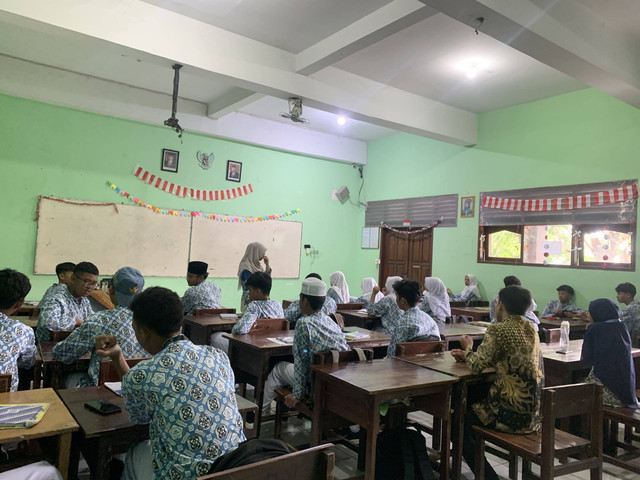Tentang KamiPedoman Media SiberKetentuan & Kebijakan PrivasiPanduan KomunitasPeringkat PenulisCara Menulis di kumparanInformasi Kerja SamaBantuanIklanKarir
2025 © PT Dynamo Media Network
Version 1.103.0
Konten dari Pengguna
Differentiated Learning: Efforts to Fulfill Students' Learning Needs
31 Desember 2024 10:16 WIB
·
waktu baca 5 menitTulisan dari Herdiyanti Putri Mu'asaroh tidak mewakili pandangan dari redaksi kumparan

ADVERTISEMENT
In teaching and learning activities, each student has different characteristics, learning styles, and speed of understanding. To meet these diverse learning needs, conventional learning approaches are no longer relevant, because this approach is not responsive enough to the unique learning needs of each student, so that students do not feel motivated to learn. Differentiated learning emerges as an innovative solution that allows each student to learn according to their potential and needs.
ADVERTISEMENT
What is Differentiated Learning?
Differentiated learning is a learning approach designed to respond to the individual needs of students. According to Tomlinson, differentiated learning is learning that accommodates, serves, and recognizes the diversity of students in learning according to the needs and learning preferences of students (Naibaho 2023). The application of differentiated learning strategies is able to show learning process activities that are in accordance with the needs of students, both in terms of learning readiness, learning interests and learning styles of students (Maulidia and Prafitasari 2023). Teachers not only present learning materials uniformly, but also adjust the content, process, product, and learning environment to suit the learning readiness, interests, and learning profile of each student.
ADVERTISEMENT
Why is Differentiated Learning Important?
Differentiated learning is very important because it recognizes that each student has different characteristics, learning styles, and learning speeds. The benefits offered include:
1. Increasing Learning Motivation, when students feel that the learning material is relevant and challenging according to their abilities, their learning motivation will increase.
2. Increasing Learning Achievement, with learning that is tailored to the needs of students, students can reach their maximum potential and obtain optimal learning outcomes.
3. Developing 21st Century Skills, differentiated learning encourages students to develop critical, creative, collaborative, and communication thinking skills that are very much needed in the digital era.
4. Making Learning More Fun, with more varied learning activities, students will feel more involved and enjoy the learning process.
ADVERTISEMENT
What needs to be prepared?
To implement differentiated learning, teachers need to take the following steps:
1. Get to know students, teachers need to understand the characteristics, interests, and learning styles of each student through various methods, such as observation, interviews, and diagnostic tests.
2. Planning learning, teachers need to design flexible learning and provide various choices for students.
3. Providing feedback, teachers need to provide constructive and specific feedback to each student to help them improve themselves.
4. Creating a supportive learning environment, teachers need to create a positive and inclusive classroom atmosphere, where all students feel valued and supported.
What is the Differentiated Learning Implementation Strategy?
The differentiated learning implementation strategy can be adjusted to class conditions and the subject matter being taught. Namely, it can be done by modifying four main components (Isrotun 2022):
ADVERTISEMENT
1. Content, teachers can provide subject matter at various levels of difficulty, depth, and complexity. For example, teachers can provide questions with different levels of difficulty, ranging from simple questions to more complex questions.
2. Process, teachers can offer a variety of learning strategies, such as group discussions, individual projects, or problem-based learning, to accommodate different learning styles. For example, teachers can divide students into small groups to work on a project to bake cookies using fractions, or give individual assignments to create presentations about the concept of fractions.
3. Product, teachers can provide final assignments that vary in form and level of complexity, so that students can demonstrate their understanding in different ways. For example, teachers can ask students to create posters, videos, or 3D models to explain the concept of fractions.
ADVERTISEMENT
4. Learning Environment, teachers can create a flexible and supportive learning environment, where students can work independently or collaborate with their peers. For example, teachers can provide a variety of props, such as fraction cards, circles, and number lines, that students can use to help them understand the concept of fractions.
What Are the Possible Challenges?
Although differentiated learning has many benefits, its implementation also faces several challenges, including (Supriana, Liliani, and Luthfia 2024):
1. Lack of Time, teachers often find it difficult to prepare various materials and different learning activities. However, this can be overcome by collaborating with Colleagues. Teachers can share ideas and resources with fellow teachers to design differentiated learning.
ADVERTISEMENT
2. Lack of Resources, not all schools have adequate facilities and resources to support differentiated learning. Therefore, teachers must be able to utilize technology to help manage heterogeneous classes and provide various interesting learning resources.
3. Lack of Teacher Skills, not all teachers have the skills needed to design and implement differentiated learning. The solution is that teachers can take relevant training to improve their skills in designing and implementing differentiated learning.
Differentiated learning is a very relevant learning approach in the current educational context. By implementing differentiated learning, teachers can help each student reach their maximum potential and prepare them to face future challenges.
References
Isrotun, Umi. 2022. “Proses Pembelajaran Melibatkan l Upaya Memenuhi Kebutuhan Belajar Peserta Didik Melalui Pembelajaran Berdiferensiasi.” In Seminar Nasional Teknologi Dan Multidisiplin Ilmu (SEMNASTEKMU), 2:312–21.
ADVERTISEMENT
Maulidia, Feny Rahma, and Aulya Nanda Prafitasari. 2023. “Strategi Pembelajaran Berdiferensiasi Dalam Memenuhi Kebutuhan Belajar Peserta Didik.” ScienceEdu, 55–63.
Naibaho, Dwi Putriana. 2023. “Strategi Pembelajaran Berdiferensiasi Mampu Meningkatkan Pemahaman Belajar Peserta Didik.” Journal of Creative Student Research 1 (2): 81–91.
Supriana, Edi, Novia Tita Liliani, and Rifda Zulfa Luthfia. 2024. “TANTANGAN IMPLEMENTASI PEMBELAJARAN BERDIFERENSIASI: SEBUAH STUDI LITERATUR.” Jurnal Pembelajaran, Bimbingan, Dan Pengelolaan Pendidikan 4 (5): 9.

